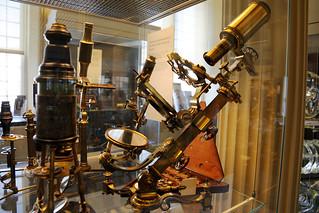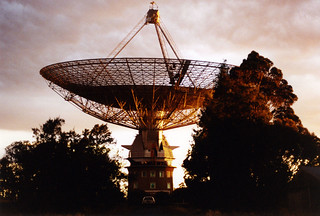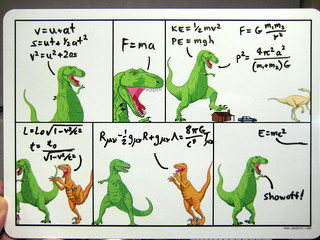
Main quadrangle at the University of Sydney. |
How does science work?
Interesting question! I'm glad you asked.
When I was an undergraduate at university, one of the courses I had to take for my studies in physics was one called History and Philosophy of Science. It wasn't a science course as such; it was a history course about science. It seemed a bit silly to me at the time to learn about how the Ancient Greeks thought the universe worked, rather than how it really works. But in their wisdom the organisers of the physics programme at the University of Sydney decided that this was a good thing, and in the fullness of time I've realised they were right. If you really want to understand a subject, you need to understand the history of that subject.
We could potentially go back further and ask about how Bronze Age or Stone Age people did science. But we have very few archaeological details of value to the question. The people of those ages tinkered around and came up with technological innovations, but did not leave lasting records of how they thought about these things. What we do have are myths that attempt to explain why the world is the way it is. Typically these involve deities or other supernatural entities with the abilities to shape and influence the world.
The
Ancient Greeks were different. They had myths about gods too, but they also had people who thought about the world in another way. People who looked at the world and saw not the invisible and capricious influence of supernatural beings that nobody could see, but rather a set of laws and rules that nature followed. They saw order rather than chaos. And they applied the concept of logical thought and deduction to try to understand those laws. (To be fair, earlier cultures probably had some people who thought this way too, but the Greeks were the first ones to make records about it that survived to be passed down to us today.)
In other words, the Greeks were doing a kind of science. But it wasn't the same sort of science that we do today. They would ponder a problem, such as, "why do objects fall to the ground?" and try to come up with an answer by thinking about it. The answer they came up with to this particular problem is interesting. It is essentially as follows:
Heavy objects fall to the ground because that is the natural place for them to be. Anyone who sees a rock in mid-air knows that that is not the natural place for the rock to be - it should be on the ground! And so the rock moves so that it ends up on the ground; in other words, it falls. But that is not all. There are different types of things, dominated by four elements: earth, water, air, and fire. Water also falls to the ground, but stones will sink in water. And air bubbles in water will rise to join the air above. Finally, fire tries to rise above the air. So it seems clear that there is a natural series of layers, with earth at the bottom, then water, then air, and fire above the air. Any object in the wrong place tries to head back to its natural layer. Rocks fall, bubbles rise in water, water springs up from the ground, fire rises up into the air.
This sort of explanation is called a teleological explanation. Objects are considered to have a sort of "desire" or "want" to behave in a certain way. Rocks "want" to be on the ground rather than in mid-air, so they fall. This is an easy way of thinking to get into, because we interact with human beings and animals, and these have wants and desires of their own, which lead to their behaviours. If a dog is hungry, it will seek food. if a child is upset, it will cry. Our minds turn these around: If a dog seeks food, then clearly it must be hungry. If a child cries, obviously it is upset. If a rock falls, then it's plain that it must want to be on the ground.
The interesting thing about this teleological explanation for how the world works is that it kind of works, in the sense that it explains why things happen, and lets you figure some things out. In a sense this is not that surprising, because the explanation was devised after some heavy thinking about what sorts of things happen in the world, and it was developed to match up with most of it. In another sense, it's astonishing, because it's so far removed from how we think of the world working today. People with a modern education know that rocks don't "want" anything or have any "natural" place to be. Rocks fall because the Earth is a large mass that has a gravitational field which exerts an attractive force on other massive objects.

Apple tree at Trinity College, Cambridge, purported to be a direct descendant of Newton's tree. |
What is the real difference between these two different explanations? Why is it
better or
more accurate in some sense to describe rocks falling with gravity rather than a desire to be in their natural place?
The difference in terms of science is that the explanation in terms of gravity is more successful at explaining things. The Ancient Greeks had no grasp of the structure of the universe beyond the Earth. There was Earth below, sky above, and beyond that were the heavens, the realm of the stars and the gods. These things were unknown and unknowable, so the subject of speculation. There was fire up there, and possibly a fifth element, or quintessence, which characterised the divine realm. They observed the planets moving around, but there was no conception that they were places like Earth - giant balls of rock and gas moving through space, all circling the sun. And beyond were more suns, and beyond those galaxies made up of billions of suns swirling around together like exquisitely choreographed dancers.
The Ancient Greek teleological system has no explanation for all of this. Gravity does.
But gravity as we understand it now is not the same thing as Isaac Newton figured out after seeing that apple fall in Cambridge. What Newton did in the 17th century was formulate an explanation for the movements of the planets as laid out by Johannes Kepler in his laws of planetary motion, which had been derived from painstaking observations of exactly how those planets moved through the sky.[1] Newton discovered that a relatively simple mathematical relationship between the masses and distances of objects governed how they moved with respect to one another. He then calculated and showed that this relationship produced the laws of planetary motion that Kepler had discovered from observations. In other words, Newton's new theory of gravity explained everything that was then known about the movements of objects, both on Earth, and among the planets. This is already significantly better than the Ancient Greek explanation.

Observations can be made through a microscope. |
What we know in science goes through several stages. It's not always the same path, but there is a loose generality about the process. A rough rundown is as follows:
- Firstly, people make observations about some aspect of the natural world. This does not necessarily mean formal "scientific" observations, with guys in lab coats taking notes on clipboards. You can make observations just as easily by yourself. Go outside and watch a bird fly through the air. That's an observation. Many observations are made by everyone just going about their daily lives. If you want to explain the universe, you need to explain all of these observations. Clearly birds fly - everyone knows that because they observe it nearly every day. How do they fly? Ah, that's the interesting part.
- The next step is to think about observations a bit, and come up with some sort of possible explanation for them. This stage is sometimes known as formulating a hypothesis. A hypothesis is a proposed explanation for some aspect of the universe. It is a speculation, although a speculation informed by observations. You wouldn't form a hypothesis that birds fly with the help of rocket packs, because your observations quite clearly conflict with this. You might form a hypothesis that birds fly by propelling air downwards with their wings, thus providing a reaction force that lifts them up into the air.
- Once you have a hypothesis, you can start examining it to see how likely it is to work. A good hypothesis is one that is generalisable and potentially explains other observations that one might be able to make. You can examine your bird flight hypothesis and apply it to new observations of different birds, and potentially to observations of butterflies and bats and other flying creatures. This is called doing experiments. Experiments are really observations, but made in the specific context of wanting to learn more about what it is you're observing, and sometimes involving deliberate manipulations to set up the conditions under which your desired observations can take place. For example, if you want to observe how birds behave, you can wait for a bird to come along, or you can go out and look for birds or capture birds and observe them from close up.

Experiments can be done with a radio telescope. |
- Experiments can involve many different types of activity. The word "experiment" typically conjures up an image of a scientist in a lab coat, perhaps mixing colourful chemicals. While some scientists certainly do this as part of their experimental work, others do a wide variety of things. They observe stars and galaxies using telescopes. They assemble lasers and lenses on precisely engineered slabs of steel. They dump piles of rocks into giant tanks of water and measure the waves. They go to Africa and chip away at rocks. They look through historical records. They analyse samples of rocks or trees or fossils in machines that extract details about the atoms in the sample. They take immensely magnified images of tiny objects. They run complex simulations on computers. All of these can be valid experimental activities.
- In an idealised version of this whole process, it is often said that when you have a hypothesis, you begin further investigation by making a prediction. To do this, you take your hypothesis and you apply it to a situation which you have not yet observed (and for which you have no knowledge about any possible observations by other people). For example, you might take your bird hypothesis and predict several things: that butterflies also fly by propelling air downwards with their wings; or that jet planes fly by propelling air downwards with their wings; or that if you took a bird and let it take off from a pressure sensitive plate, you could measure the downwards movement of air from its wings; or that the overall movement of air from bird wings all over the world increases the air pressure in area where there are lots of birds. Any of these is a potential prediction based on your hypothesis. Some of them are wrong, some might be right. What you do next is test your prediction - by performing an experiment.

Sometimes collecting data involves literal collecting. |
- Often—sometimes more often than not—you don't actually go ahead with testing a specific prediction based on your hypothesis. You might not even have a good working hypothesis at all. But you go ahead and perform experiments anyway. If you want to learn more about birds flying, you might go observe more birds, or you might observe butterflies and jet planes, or you might catch birds and do things in the lab with wind gauges and stuff. All of this adds more data to your process. Data are really the distilled results of observations and experiments, expressed in a way that is (hopefully) relatively easy to take in. Collecting more data by performing experiments is a way to gather enough data to put the pieces of a half-formed hypothesis together in your mind. You don't have an idea about how things work, so you do experiments and collect more data until things start to fall into place in your mind.
- Once you do have a hypothesis, the new data you collect can either fit in with it, or contradict it. If your hypothesis was "All flying things fly by pushing air downwards with their wings", then studies of birds and of butterflies and bats might fit in with it, but studies of jet planes would not. When you take the right measurements of a jet plane, you'll find they don't flap their wings, so your hypothesis doesn't work. However all is not lost. Your hypothesis just might be a bit too broad. Now you refine your hypothesis. It doesn't work for all flying things, but maybe it still works for birds. By performing experiments, you narrow down a hypothesis to the areas where it has value and eliminate those where it doesn't.
- The real test of a hypothesis is when you manage to formulate one that can make a prediction, as mentioned above, and you can do an experiment to test whether the prediction comes true or not. You catch a bird and measure any downwards movement of air when it flaps its wings and you find that air does indeed move downwards under a wing when it flaps. This supports your hypothesis! If you could not find any downwards moving air when a bird flapped its wings, that would contradict your hypothesis.
- If something contradicts your hypothesis, then you need to go back and try to figure out a new hypothesis that potentially explains all the previous observations and the results of your new experiments. Maybe you find some birds that fly for extended periods without flapping their wings at all! Your new hypothesis might be that birds fly either by flapping their wings to move air downwards, or by finding places where the air is rising upwards underneath them. In real life there are often multiple conditions that apply and change the details of what the hypothesis is trying to explain. To do science properly, you need to take all of those cases into account. Objects fall at the same speed - except when there is air resistance which affects the aerodynamic properties of the objects. Or rising columns of air. Or the objects have flapping wings.

A bird that can fly for long distances without flapping its wings. Magnificent frigatebird. |
- On the other hand, your new experiments could match your prediction. Maybe having shown that birds fly either by flapping their wings or by riding updrafts of air, you want to extend this hypothesis to butterflies and bats. You measure butterflies and bats, and find they indeed seem to fly in the same way. This constitutes evidence that your hypothesis might be a valid description of reality. But it does not prove your hypothesis is correct.
- If your hypothesis makes multiple different predictions, and all of them turn out to be supported when suitable experiments are done, then the evidence in favour of the hypothesis gets stronger. This is especially so if one simple observation or experimental result could disprove your hypothesis. The discovery of a single bird with rockets on its wings could disprove your hypothesis about bird flight - but over years and years of observations none are found. This is kind of a silly example at this point, because we all know very well that birds don't have rockets. But it's not all that silly, really. If we did find a bird that flew using rockets burning chemical fuel, it would not only destroy our example hypothesis here, it would also destroy much of what we know about biology and evolution. You can easily think of dozens, hundreds, thousands of potential observations that would disprove certain aspects of modern science. The fact that these are never observed demonstrates the solidity of the foundations of our current science.
- Going further, if your hypothesis survives the test of time and multiple experiments, and nothing is ever found that contradicts it, and it explains several aspects of the natural world, then your hypothesis might be "upgraded" to the status of a theory. This is what happened to Einstein's Theory of Relativity. Test after test after test showed that it worked. Never once did it fail. It explained thousands of observations, both on Earth and amongst the planets and stars. It's as good a scientific hypothesis as you're ever likely to get.

Science is a constant process of upgrading your knowledge. |
A scientific theory is a very different thing to a "theory" in the vernacular English language. For most people, a "theory" means essentially the same thing as a hypothesis - an attempt to explain something which might, or equally as well might not, be true. If your rubbish bin is knocked over in the morning, you might have a "theory" that the cat did it. Maybe the cat did, maybe it didn't. This is the source of at least some of the confusion amongst the public over the status of things like the Theory of Relativity or, more tragically, the Theory of Evolution. These are scientific theories, meaning they are supported by decades of observations and literally millions of experiments by thousands of researchers all around the world, and form the absolute best descriptions of the nature of space/time and of the relationships between living beings, respectively, that we know of. They are not things that are "Well, it's just a theory, maybe it happens that way or maybe it doesn't". Of the two, in fact, evolution is by far on more solid ground. There are corners of theoretical physics, high energy physics, particle physics, astrophysics, and cosmology where there are hints that Einstein's Theory of Relativity may need updating or modifying. But there is nothing, absolutely nothing, not a single observation anywhere, that even suggests the vague possibility that biological evolution does not actually happen.
- In some instances, if your hypothesis is a simple statement of how things happen in certain cases, without an overarching body of explanation behind it, then instead of a scientific theory, it might get termed a law. Newton's description of gravity can be distilled down to a single, simple mathematical equation. It describes the forces massive bodies feel when near one another. But that's all it does - it doesn't say why this happens or concern itself with where mass comes from. Other examples of scientific laws are Kepler's laws of planetary motion - they describe how the planets move, but not why they move that way. In contrast, Einstein's theory of relativity provides a complete framework which describes space and time, and explains why Newton's law of gravity works in most cases and also under what condition's Newton's law fails to work. Really, a scientific theory is a much grander and deeper thing than a mere scientific law.

The scientific method applied to wine tasting. I got together with a group of friends and we had a non-participant decant six white wines of different types into numbered decanters. We tasted them and tried to describe the aromas and flavours of each wine without knowing what they were.
Result? It's really easy to distinguish a Chardonnay. |
- The last thing about all scientific hypotheses, theories, and laws, is that they must be falsifiable. This means that, in principle, there could be an experiment you could do or an observation you could make that, if a certain outcome was seen, would disprove the hypothesis, theory, or law. If you found a bird with rocket engines, that would disprove your bird hypothesis. If you dropped a stone and it didn't fall to the ground, that would disprove Newton's law of gravity (and Einstein's theory of relativity). If you found human fossils in layers of rock older than rock in which you find dinosaurs, that would disprove many aspects of evolutionary biology. But none of these things have ever been seen. If they were seen, the theories would have to change or be scrapped. There are no sacred cows in science; everything is up for being disproved.
This point about being falsifiable, that all scientific theories can potentially be disproved if they are wrong, comes with a complimentary property: scientific theories can never be proved beyond all doubt to be true. You can have extreme confidence that the law of gravity works, that
every single time you drop a rock it will fall. In fact, given what we know and have observed over human history, it would be ignorant or stupid or obtuse to believe otherwise. But nevertheless, it is conceivably possible that next time you drop a rock it will hang there in mid-air, and Newton's law of gravity will need to be scrapped. The law of gravity can never be
proved to be true, because there is always the possibility that the next experiment will uncover the data that disproves it. However, given all we know about the universe, that possibility is so extremely remote that for all intents and purposes we can ignore it. Aerospace engineers
do not take into account the possibility that the law of gravity is wrong, and that assumption has not led to any disasters. (Air disasters are caused by other things, not some misunderstanding about the nature of gravity.)
All of this process described above is often referred to as the scientific method. It is a procedure and a philosophical framework for doing science in a way that is rigorous and methodical.

A perfectly typical scientist. |
The scientific method, which critically involves experiment and observation, is a fairly recent construction in human history. The Ancient Greeks used a different method of understanding the world. Their method was based on the idea that you could understand the world purely by thinking about it, by applying logic. This led to theories like the teleological view of the world and the system of four elements. Modern scientific thinking began somewhere in the period from the Middle Ages to the Renaissance, when people began developing technologies that showed the limitations of the Greek theories, and doing practical engineering and experimentation to figure out what was going on.
Ideally, this description of the scientific method is what scientists do when they investigate the universe. In practice, things are never as neat, and the steps can be jumbled up, or undertaken with more or less rigour. And scientists are people. Which means they have human egos and preferences and failings. Science is littered with stories of personality clashes and bitter rivalries. Of people inventing experimental results and covering up others. Of denouncements and feuds and persecution. But the good thing about science is that what is wrong will be found out in the end. The important thing is that at some point, any hypothesis will come under the scrutiny of someone who could potentially disprove it with some experiment. Hypotheses that survive this scrutiny have a chance to go on and become integrated into our way of thinking about the universe - our model of the universe. The more important a hypothesis is, the more it speaks about, the more different phenomena it purports to explain, the more scrutiny it gets.
Science is a process for proving that false things are wrong. It is a very strong and powerful process for doing so. If some hypothesis or theory is wrong, science will find it out, irrespective of who came up with it, who they were friends or enemies with, or what their political or social views were.
Anything which can survive this process, which explains part of our universe without falling foul of experiments and observations, particularly if carried out by multiple scientists over tens or hundreds of years, deserves our respect. It is the seed, the germ of knowledge, winnowed from the surrounding chaff of myth and superstition and pseudoscience by the most powerful process we have brought to bear on the world around us. The great, grand theories we have—relativity, quantum mechanics, evolution, plate tectonics, the Big Bang, thermodynamics, cell theory, stellar evolution, electromagnetism, the germ theory of disease, atomic theory—these explain much about the world and universe around us, in elegant and appealing ways that make sense of an enormous number of disparate observations and facts. Without them, no disrespect to the Ancient Greeks, but our civilisation would be not be that much different technologically than theirs.
[1] This is discussed briefly in
this annotation about Mars.










